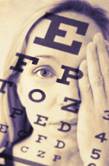 |
 |
 |

Cases of Age-Related Farsightedness to Soar
Presbyopia already affects more than 1 billion people worldwide, study says|
|
HealthDay
By Robert Preidt
Tuesday, December 9, 2008
 TUESDAY, Dec. 9 (HealthDay News) -- More than 1 billion people worldwide had age-related farsightedness -- called presbyopia -- in 2005.
TUESDAY, Dec. 9 (HealthDay News) -- More than 1 billion people worldwide had age-related farsightedness -- called presbyopia -- in 2005.
And about 410 million of those people were unable to perform tasks that required near vision, according to researchers who predicted that global cases of presbyopia will increase to 1.4 billion by 2020 and 1.8 billion by 2050.
Presbyopia occurs as lenses in aging eyes lose elasticity and the ability to focus on close objects. The condition typically requires older people to use reading glasses, for instance.
"Although known physiology and population demographics suggest that presbyopia is common or nearly universal in people older than 65 years, direct estimates of prevalence are rare," Brien A. Holden, of the University of New South Wales in Sydney, Australia, and colleagues noted in the study. "The total number of people with presbyopia is primarily of interest as a precursor to the figures of greatest public health interest: the number of people with impaired vision due to uncorrected or undercorrected presbyopia and the effect on their lives."
The researchers analyzed multiple surveys and concluded that 1.04 billion people worldwide had presbyopia in 2005 and that 517 million had no eyeglasses or inadequate eyeglasses. Of the 517 million people whose daily tasks were impaired by uncorrected presbyopia, 386 million (94 percent) lived in developing nations.
Holden and his colleagues also used the International Data Base of the U.S. Census Bureau to predict future rates of presbyopia and presbyopia-related disability.
"Without intervention to make [eyeglasses] more accessible, the global number of individuals who will have a disability associated with uncorrected presbyopia is predicted to grow to 563 million people by 2020," the researchers wrote. "If the goal of Vision 2020 to eliminate unnecessary blindness and impaired vision, in this case due to uncorrected refractive error, is to be achieved, planning will have to include the provision of human resources, affordable [eyeglasses] and systems of delivery for these half-billion people in need."
The study was published in the December issue of the Archives of Ophthalmology.
HealthDay
Copyright (c) 2008 ScoutNews, LLC. All rights reserved.
Related News:
More News on this Date
Related MedlinePlus Pages:
| Home | Health Topics | Drugs & Supplements | Encyclopedia | Dictionary | News | Directories | Other Resources | |
| Disclaimers | Copyright | Privacy | Accessibility | Quality Guidelines U.S. National Library of Medicine, 8600 Rockville Pike, Bethesda, MD 20894 National Institutes of Health | Department of Health & Human Services |
Date last updated: 10 December 2008 |




